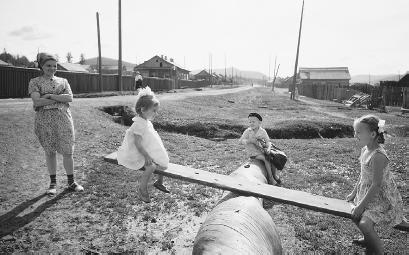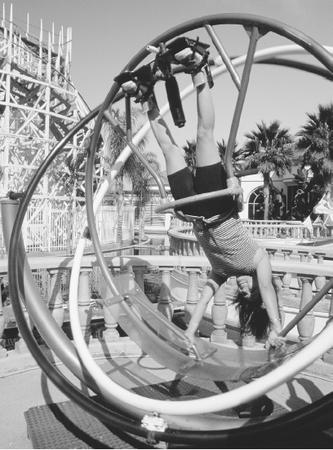Torque - Real-life applications

Seesaws and Wrenches
As for what torque is and how it works, it is best discuss it in relationship to actual objects in the physical world. Two in particular are favorites among physicists discussing torque: a seesaw and a wrench turning a lug nut. Both provide an easy means of illustrating the two ingredients of torque, force and moment arm.
In any object experiencing torque, there is a pivot point, which on the seesaw is the balance-point, and which in the wrench-and-lug nut combination is the lug nut itself. This is the area around which all the forces are directed. In each

Whereas force is equal to mass multiplied by acceleration, weight is equal to mass multiplied by the acceleration due to gravity. The latter is equal to 32 ft (9.8 m)/sec 2 . This means that for every second that an object experiencing gravitational force continues to fall, its velocity increases at the rate of 32 ft or 9.8 m per second. Thus, the formula for weight is essentially the same as that for force, with a more specific variety of acceleration substituted for the generalized term in the equation for force.
As for moment arm, this is the distance from the pivot point to the vector on which force is being applied. Moment arm is always perpendicular to the direction of force. Consider a wrench operating on a lug nut. The nut, as noted earlier, is the pivot point, and the moment arm is the distance from the lug nut to the place where the person operating the wrench has applied force. The torque that the lug nut experiences is the product of moment arm multiplied by force.
In English units, torque is measured in pound-feet, whereas the metric unit is Newtonmeters, or N·m. (One newton is the amount of force that, when applied to 1 kg of mass, will give it an acceleration of 1 m/sec 2 ). Hence if a person were to a grip a wrench 9 in (23 cm) from the pivot point, the moment arm would be 0.75 ft (0.23 m.) If the person then applied 50 lb (11.24 N) of force, the lug nut would be experiencing 37.5 pound-feet (2.59 N·m) of torque.
The greater the amount of torque, the greater the tendency of the object to be put into rotation. In the case of a seesaw, its overall design, in particular the fact that it sits on the ground, means that its board can never undergo anything close to 360° rotation; nonetheless, the board does rotate within relatively narrow parameters. The effects of torque can be illustrated by imagining the clockwise rotational behavior of a seesaw viewed from the side, with a child sitting on the left and a teenager on the right.
Suppose the child weighs 50 lb (11.24 N) and sits 3 ft (0.91 m) from the pivot point, giving her side of the seesaw a torque of 150 pound-feet (10.28 N·m). On the other side, her teenage sister weighs 100 lb (22.48 N) and sits 6 ft (1.82 m) from the center, creating a torque of 600 pound-feet (40.91 N·m). As a result of the torque imbalance, the side holding the teenager will rotate clockwise, toward the ground, causing the child's side to also rotate clockwise—off the ground.

In order for the two to balance one another perfectly, the torque on each side has to be adjusted. One way would be by changing weight, but a more likely remedy is a change in position, and therefore, of moment arm. Since the teenager weighs exactly twice as much as the child, the moment arm on the child's side must be exactly twice as long as that on the teenager's.
Hence, a remedy would be for the two to switch positions with regard to the pivot point. The child would then move out an additional 3 ft (.91 m), to a distance of 6 ft (1.83 m) from the pivot, and the teenager would cut her distance from the pivot point in half, to just 3 ft (.91 m). In fact, however, any solution that gave the child a moment arm twice as long as that of the teenager would work: hence, if the teenager sat 1 ft (.3 m) from the pivot point, the child should be at 2 ft (.61 m) in order to maintain the balance, and so on.
On the other hand, there are many situations in which you may be unable to increase force, but can increase moment arm. Suppose you were trying to disengage a particularly stubborn lug nut, and after applying all your force, it still would not come loose. The solution would be to increase moment arm, either by grasping the wrench further from the pivot point, or by using a longer wrench.
For the same reason, on a door, the knob is placed as far as possible from the hinges. Here the hinge is the pivot point, and the door itself is the moment arm. In some situations of torque, however, moment arm may extend over "empty space," and for this reason, the handle of a wrench is not exactly the same as its moment arm. If one applies force on the wrench at a 90°-angle to the handle, then indeed handle and moment arm are identical; however, if that force were at a 45° angle, then the moment arm would be outside the handle, because moment arm and force are always perpendicular. And if one were to pull the wrench away from the lug nut, then there would be 0° difference between the direction of force and the pivot point—meaning that moment arm (and hence torque) would also be equal to zero.
Gyroscopes
A gyroscope consists of a wheel-like disk, called a flywheel, mounted on an axle, which in turn is mounted on a larger ring perpendicular to the plane of the wheel itself. An outer circle on the same plane as the flywheel provides structural stability, and indeed, the gyroscope may include several such concentric rings. Its focal point, however, is the flywheel and the axle. One end of the axle is typically attached to some outside object, while the other end is left free to float.
Once the flywheel is set spinning, gravity has a tendency to pull the unattached end of the axle downward, rotating it on an axis perpendicular to that of the flywheel. This should cause the gyroscope to fall over, but instead it begins to spin a third axis, a horizontal axis perpendicular both to the plane of the flywheel and to the direction of gravity. Thus, it is spinning on three axes, and as a result becomes very stable—that is, very resistant toward outside attempts to upset its balance.
This in turn makes the gyroscope a valued instrument for navigation: due to its high degree of gyroscopic inertia, it resists changes in orientation, and thus can guide a ship toward its destination. Gyroscopes, rather than magnets, are often the key element in a compass. A magnet will point to magnetic north, some distance from "true north" (that is, the North Pole.) But with a gyroscope whose axle has been aligned with true north before the flywheel is set spinning, it is possible to possess a much more accurate directional indicator. For this reason, gyroscopes are used on airplanes—particularly those flying over the poles—as well as submarines and even the Space Shuttle.
Torque, along with angular momentum, is the leading factor dictating the motion of a gyroscope. Think of angular momentum as the momentum (mass multiplied by velocity) that a turning object acquires. Due to a principle known as the conservation of angular momentum, a spinning object has a tendency to reach a constant level of angular momentum, and in order to do this, the sum of the external torques acting on the system must be reduced to zero. Thus angular momentum "wants" or "needs" to cancel out torque.
The "right-hand rule" can help you to understand the torque in a system such as the gyroscope. If you extend your right hand, palm downward, your fingers are analogous to the moment arm. Now if you curl your fingers downward, toward the ground, then your fingertips point in the direction of g —that is, gravitational force. At that point, your thumb (involuntarily, due to the bone structure of the hand) points in the direction of the torque vector.
When the gyroscope starts to spin, the vectors of angular momentum and torque are at odds with one another. Were this situation to persist, it would destabilize the gyroscope; instead, however, the two come into alignment. Using the right-hand rule, the torque vector on a gyroscope is horizontal in direction, and the vector of angular momentum eventually aligns with it. To achieve this, the gyroscope experiences what is known as gyroscopic precession, pivoting along its support post in an effort to bring angular momentum into alignment with torque. Once this happens, there is no net torque on the system, and the conservation of angular momentum is in effect.
Torque in Complex Machines
Torque is a factor in several complex machines such as the electric motor that—with variations—runs most household appliances. It is especially important to the operation of automobiles, playing a significant role in the engine and transmission.
An automobile engine produces energy, which the pistons or rotor convert into torque for transmission to the wheels. Though torque is greatest at high speeds, the amount of torque needed to operate a car does not always vary proportionately with speed. At moderate speeds and on level roads, the engine does not need to provide a great deal of torque. But when the car is starting, or climbing a steep hill, it is important that the engine supply enough torque to keep the car running; otherwise it will stall. To allocate torque and speed appropriately, the engine may decrease or increase the number of revolutions per minute to which the rotors are subjected.
Torque comes from the engine, but it has to be supplied to the transmission. In an automatic transmission, there are two principal components: the automatic gearbox and the torque converter. It is the job of the torque converter to transmit power from the flywheel of the engine to the gearbox, and it has to do so as smoothly as possible. The torque converter consists of three elements: an impeller, which is turned by the engine flywheel; a reactor that passes this motion on to a turbine; and the turbine itself, which turns the input shaft on the automatic gearbox. An infusion of oil to the converter assists the impeller and turbine in synchronizing movement, and this alignment of elements in the torque converter creates a smooth relationship between engine and gearbox. This also leads to an increase in the car's overall torque—that is, its turning force.
Torque is also important in the operation of electric motors, found in everything from vacuum cleaners and dishwashers to computer printers and videocassette recorders to subway systems and water-pumping stations. Torque in the context of electricity involves reference to a number of concepts beyond the scope of this discussion: current, conduction, magnetic field, and other topics relevant to electromagnetic force.
WHERE TO LEARN MORE
Beiser, Arthur. Physics, 5th ed. Reading, MA: Addison-Wesley, 1991.
Macaulay, David. The New Way Things Work. Boston: Houghton Mifflin, 1998.
"Rotational Motion." Physics Department, University of Guelph (Web site). <http://www.physics.uoguelph.ca/tutorials/torque/> (March 4, 2001).
"Rotational Motion—Torque." Lee College (Web site). <http://www.lee.edu/mathscience/physics/physics/Courses/LabManual/2b/2b.html> (March 4, 2001).
Schweiger, Peggy E. "Torque" (Web site). <http://www.cyberclassrooms.net/~pschweiger/rotmot.html> (March 4, 2001).
"Torque and Rotational Motion" (Web site). <http://online.cctt.org/curriculumguide/units/torque.asp> (March 4, 2001).